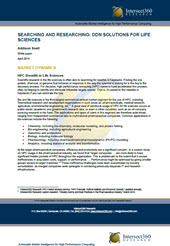
HPC Breadth in Life Sciences - Scientific research in the life sciences is often akin to searching for needles in haystacks. Finding the one protein, chemical, or genome that behaves or responds in the way the scientist is looking for is the key to the discovery process. For decades, high performance computing (HPC) systems have accelerated this process, often by helping to identify and eliminate infeasible targets sooner. That is, it’s easier to find needles in haystacks if you can eliminate the hay.
Bio and life sciences is the third-largest commercial vertical market segment for the use of HPC, including “biomedical research and development organizations in such areas as: pharmaceuticals, medical research, agriculture, environmental engineering, etc.”1 A great deal of additional usage of HPC for life sciences occurs at public-sector (academic and government) research labs, or even in other industries, such as an oil company pursuing research in bio fuels. The applications and types of users in this segment are therefore quite broad, ranging from independent commercial labs to multinational pharmaceutical companies. Common applications in bio-sciences include the following:
- Chemistry, including bio-chemistry, molecular modeling, and protein folding
- Bio-engineering, including agricultural engineering
- Genomics and proteomics
- Biology, including molecular biology
- Pharmacology, including pharmacokinetic/pharmacodynamic (PK/PD) modeling
- Analytics, including statistical analysis and bioinformatics
At the larger pharmaceutical companies, efficiency and productivity are a significant concern. In a custom study on HPC usage in the pharmaceutical industry, we found that “larger companies … are more likely to have significant hidden pockets of HPC throughout the organization. This is problematic to the extent that it causes inefficiencies in acquisition costs, support, or performance. … Performance might be optimized by giving smaller groups access to larger machines.”2 These inefficiency challenges have been exacerbated by industry consolidation, as merged companies seek synergies in combining previously disparate IT and research infrastructures.
All information that you supply is protected by our privacy policy. By submitting your information you agree to our Terms of Use.
* All fields required.




